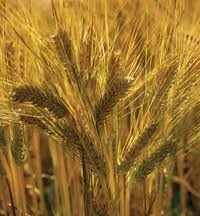Last wheat I was talking about the wheat market, and the fact that wheat is not wheat, all in preparation for a 20 minute outlook for the wheat market at the AAEA conference in Pittsburgh. I want to finish what I started.
Earlier I talked about the distinction between high and low protein, red vs. white, and hard vs. soft wheat. Today, common vs. durum and food vs. feed wheat.
Common vs. durum wheat: Common wheat is not a term heard very often because the category is so broad. It includes every type and class of wheat that is not durum wheat – wheat that is used to make the broad array of flour based products from crackers to breads to bagels. Durum wheat is unique as the semolina and durum flour produced from it is used in pasta production and has no viable substitutes from other classes of wheat. High quality pasta uses semolina from durum wheat, and not a blend of other wheat flour. There is a modest amount of blending of durum flour and hard wheat flour in the production of noodles, such as you might find in chicken noodle soup.
Food vs. feed wheat: This is where I ended my presentation because I wanted to make a point about the current market. Worldwide, wheat is more than just a food grain – every year the world feeds 16-20% of the wheat produced to animals. I blogged earlier on the amount of wheat fed in the U.S. market, which varies more than world usage. For the 2011/2012 crop year, USDA projects total U.S. wheat feeding of 220 million bushels, or 11% of total production. I think this projection is too low.
The amount of wheat fed in the U.S. hinges on two factors; price and quality. As I write, the price of wheat is very cheap relative to the price of corn. In the month of June, the price of July wheat in Chicago averaged just 97% of July corn. This is the lowest price ratio of CBOT wheat to corn that I have in my records, which go back to 1973. Kansas City wheat futures are also cheap relative to corn, and this fact is critical because, historically, the highest wheat feeding years coincide with a strong level of HRW wheat feeding.
Quality is also an issue in wheat feeding and, to be honest, the high quality of the 2011 HRW and SRW crops work against my argument for more wheat feeding. Poor quality wheat is often fed because quality discounts for poor test weight or damage provide the economic incentive to push it into feed channels. This year looks unique to me – good quality SRW wheat is trading at a discount to corn in the eastern Corn Belt while good quality HRW wheat is trading at par or at a slight discount to corn in the western and southern fringes of the HRW growing area. A wild card this year may be in the PNW, where soft white wheat which is not normally fed in great quantities is trading at a discount to some feed grains.
Given the low price of wheat relative to corn, here is my bold price prediction for wheat prices in the year ahead: As goes the price of corn, so will go the price of wheat. And wheat feeding in the U.S. and in the world will be higher than currently projected.
http://edsworld.wordpress.com/2011/07/28/wheat-market-outlook-conclusion/


Deprecated: strpos(): Passing null to parameter #1 ($haystack) of type string is deprecated in /home/agriviek8Qv/agriviet.net/public_html/wp-includes/comment-template.php on line 2522